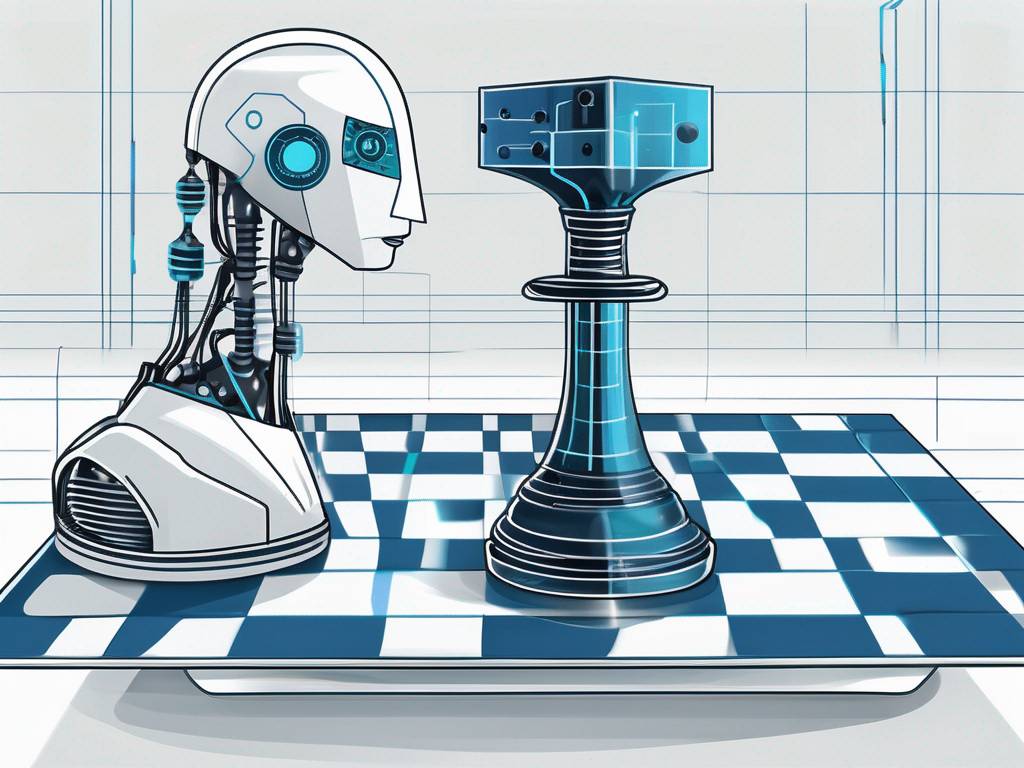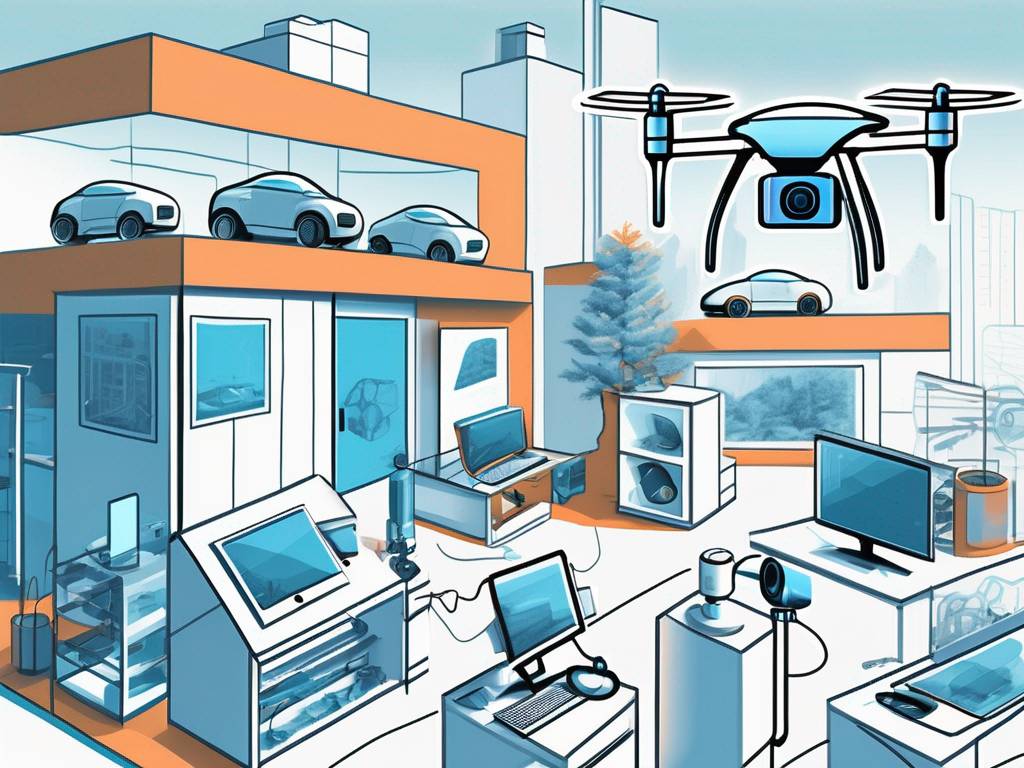Strong AI vs. Weak AI: What Makes Them Different?
Artificial Intelligence (AI) is a technology that has garnered significant attention in recent years. Within the field of AI, there are different categories that define the capabilities of these intelligent systems. Two prominent categories are weak AI and strong AI. In order to fully comprehend the distinction between these two approaches, it is essential to delve into the fundamental concepts, characteristics, and applications of each.
Understanding Artificial Intelligence
AI is a fascinating field that involves the simulation of human intelligence in machines. These machines are programmed to think and learn like human beings, enabling them to perform tasks that typically require human intelligence. AI encompasses various subfields, including machine learning, natural language processing (NLP), and computer vision.
Machine learning is a crucial aspect of AI, and involves training machines to learn from training data and improve their performance over time. This allows AI systems to adapt and make accurate predictions or decisions based on the information they receive. NLP on the other hand, focuses on enabling machines to understand and interpret human language. This technology is used in the development of voice assistants like Siri and Alexa, which can understand and respond to human commands.
Computer vision is another important subfield of AI that deals with enabling machines to see and interpret visual information. This technology is used in various applications, such as facial recognition, object detection, and autonomous vehicles. With computer vision, machines can analyze and understand images or videos, enabling them to perform tasks that were once exclusive to humans.
The Concept of AI
At its core, AI aims to replicate human intelligence in machines. By programming machines to think and learn like humans, AI systems can undertake tasks that would typically require human intelligence. For example, AI can be used to solve complex problems, recognize speech, and make informed decisions.
AI systems are designed to process and analyze vast amounts of data, enabling them to identify patterns, make predictions, and provide valuable insights. This ability to analyze data quickly and accurately has made AI an invaluable tool in various industries, including healthcare, finance, and manufacturing.
AI also has the potential to revolutionize the way we live and work. With advancements in AI technology, we can expect to see more sophisticated applications in areas such as autonomous vehicles, robotics, and personalized medicine. AI has the power to transform industries, improve efficiency, and enhance our overall quality of life.
Evolution of AI
The development of AI can be traced back to the mid-20th century when researchers first began exploring the possibilities of creating machines that could mimic human intelligence. However, early AI systems had limited capabilities and were unable to solve complex problems effectively.
Over the years, advancements in computing power and algorithms have propelled AI forward, enabling significant progress in the field. Today, AI technologies have become increasingly integrated into our daily lives. Voice assistants like Siri and Google Assistant have become commonplace, providing us with instant information and performing tasks on our behalf.
Autonomous vehicles are another notable application of AI. AI algorithms help self driving car navigate and make decisions on the road, with the goal of improving safety and efficiency. AI-powered robots are also being developed to assist in various tasks, from manufacturing to healthcare.
As AI continues to evolve, researchers and developers are constantly pushing the boundaries of what is possible. The future of AI holds immense potential, with the promise of even more advanced technologies that can revolutionize industries and transform the way we live.
Defining Weak AI
Weak AI, also known as narrow AI or artificial narrow intelligence, refers to AI systems specifically designed to perform certain tasks within a limited context. These systems operate based on training data, enabling them to excel in particular domains. However, despite their impressive performance in tasks such as language translation or facial recognition, weak AI systems are confined to their programmed areas of expertise. They lack the general intelligence, human intellect, and adaptability that would allow them to extend their capabilities beyond these narrow applications.
While weak AI may not possess the cognitive abilities of human intelligence, it is still a powerful tool that has revolutionized various industries. By focusing on specific tasks, weak AI can achieve remarkable accuracy and efficiency, making it an invaluable asset in today’s technological landscape.
Characteristics of Weak AI
One key characteristic of weak AI is its dependence on predefined programming. These systems are developed using specific algorithms and rules that guide their behavior. Although they can enhance their performance over time through machine learning techniques, their capabilities remain fundamentally limited by their initial programming. For instance, in speech recognition, such systems can recognize and process speech based on their programming. However, they do not possess cognitive abilities to understand or interpret context as a human would.
Weak AI systems are also designed to interact with and respond to human input. They are typically programmed to understand and process natural language, allowing them to communicate effectively with users. This capability makes them ideal for applications such as customer service chatbots and virtual personal assistants.
Applications of Weak AI
The applications of weak AI are both vast and diverse. These systems are adept at understanding and responding to user queries, offering pertinent information, and aiding in a multitude of tasks. As a result, weak AI is frequently employed in areas such as customer service chatbots, recommendation engines, and virtual personal assistants. Their ability to handle specific, programmed tasks efficiently makes them invaluable in these contexts.
In the field of healthcare, weak AI is making significant strides. Medical diagnosis systems powered by weak AI algorithms can analyze vast amounts of patient data, including medical records, test results, and symptoms, to provide healthcare professionals with potential treatment options. This not only helps doctors make more informed decisions, but also improves the accuracy and efficiency of diagnosis.
Weak AI is also extensively used in the finance industry. AI-powered trading algorithms can analyze market data, identify patterns, and make predictions to assist traders in making informed investment decisions. Additionally, AI-based fraud detection systems can analyze large volumes of financial transactions to identify suspicious activities and prevent fraudulent transactions.
In the manufacturing sector, weak AI plays a crucial role in optimizing production processes. AI systems can monitor and analyze real-time data from IoT sensors and machines to identify potential issues and optimize production efficiency. This leads to cost savings, improved quality control, and increased productivity.
These are just a few examples of the wide-ranging applications of weak AI. As technology continues to advance, we can expect to see even more innovative uses of weak AI in various industries, further enhancing our capabilities and improving our lives.
Exploring Strong AI
Strong AI, also known as Artificial General Intelligence (AGI), represents the pinnacle of AI research. It is envisioned as a form of intelligence that mirrors the depth and versatility of the human mind. Unlike weak AI, strong AI would have the ability to emulate human-like cognition and reasoning across a broad range of tasks, not just specialized ones. Its goal is to achieve a level of intelligence and understanding comparable to human intellect, enabling it to learn and apply knowledge in various domains. Currently, strong AI remains a theoretical concept, with no existing systems fully achieving this level of general intelligence. However, ongoing research in AI is aimed at exploring the possibilities of developing such advanced, versatile AI systems in the future.
Features of Strong AI
Strong AI systems could have the remarkable ability to understand complex concepts and learn from experience, much like humans do, employing human cognitive capacities to do these tasks. Capable of analyzing vast amounts of data to identify patterns and generate insights, strong AI could also reason, make decisions, and engage in creative problem-solving, better than humans in certain domains.
A key feature of strong AI will be its adaptability. Unlike traditional AI systems that are confined to specific tasks, strong AI could flexibly apply its intelligence across various domains. It could seamlessly transition from tasks like analyzing scientific data to understanding natural language, or even engaging in creative endeavors such as composing music or writing literature.
Strong AI may also have the potential for interaction, utilizing self-awareness to understand and respond to human emotions, gestures, and verbal cues. This capability could make them ideal for roles as companions or assistants in diverse settings, enabling them to engage in meaningful conversations, provide personalized recommendations, and offer emotional support.
Uses of Strong AI
The transformative potential of strong AI is particularly pronounced in scientific research. In laboratories, strong AI is imagined to revolutionize data analysis, uncovering novel hypotheses and patterns that elude human understanding. This would accelerate advancements in pivotal fields like medicine, quantum physics, and environmental science, leading to revolutionary breakthroughs.
In robotics, strong AI is poised to usher in a new era with the development of intelligent, adaptive companion robots. These robots, powered by strong AI, would integrate seamlessly into everyday life, tailoring their responses to individual preferences and needs. As personal assistants, they would adapt to users’ lifestyles, managing everything from home automation to personal schedules, and even offering companionship by interpreting and responding to emotional cues, thus narrowing the divide between technology and human interaction.
The entertainment industry could also undergo a radical transformation with strong AI, adding an exciting dimension to interactive media. Imagine a film or video game where AI-driven characters dynamically interact with players, offering highly immersive and constantly evolving narratives. This innovation would blur the lines between reality and virtual realms, potentially revolutionizing how we experience and interact with fictional worlds.
The Key Differences Between Weak AI & Strong AI
Functionality & Complexity
The primary distinction between weak AI and strong AI lies in their functionality and complexity. Weak AI systems are task-oriented and designed for specific purposes, such as voice recognition or image classification. These systems excel at performing well-defined tasks but lack the ability to generalize their knowledge to other domains. On the other hand, strong AI systems could possess the ability to perform tasks across diverse domains, showcasing a higher level of complexity and adaptiveness. They could understand and respond to a wide range of inputs, making them more versatile and capable of handling complex real-world scenarios.
A weak AI system designed for voice recognition may accurately transcribe spoken words into text, but it would struggle to comprehend the meaning behind those words or engage in a meaningful conversation. In contrast, it is imagined that strong AI systems will not only transcribe the words but also understand their context, interpret the speaker’s emotions, and generate an appropriate response.
Learning & Adaptability
Another critical difference stems from their learning and adaptability. Weak AI systems typically rely on pre-programmed rules or statistical models, limiting their ability to learn beyond the predetermined parameters. These systems are trained on specific datasets and can make predictions or decisions based on patterns within that data. However, they lack the capacity to learn from new experiences or adapt their behavior accordingly.
In contrast, strong AI systems may be able to learn from experiences, self-improve, and evolve their understanding of the world, mirroring the continuous learning process of human intelligence. These systems will employ advanced machine learning techniques, such as deep neural networks, to analyze data, extract meaningful insights, Identify patterns, make predictions, and refine their knowledge over time.
Weak AI is effectively employed in scientific research for data analysis, assisting in identifying patterns and correlations within large datasets. It operates by examining various scientific studies and experiments, extracting insights that might not be readily observable to researchers. In contrast, strong AI could offer a broader scope of capabilities in scientific research. It could analyze vast datasets, detect intricate correlations, and generate hypotheses for subsequent investigations. Additionally, strong AI might be capable of simulating complex systems, presenting researchers with the opportunity to explore theoretical scenarios that would be impractical or impossible to examine through traditional methods.
Overall, while weak AI systems excel at specific tasks within predefined boundaries, strong AI systems possess the ability to generalize knowledge, learn from experience, and adapt to new situations. The distinction between the two lies in their functionality, complexity, and learning capabilities, making strong AI a more promising avenue for achieving human-like intelligence.
The Future of AI: Weak or Strong?
Predictions & Possibilities
The debate surrounding the future of AI involves an exploration of the potential trajectory of weak AI and strong AI. Experts have differing opinions regarding which path AI will take. Some speculate that advancements will primarily occur within the realm of weak AI, attributing its practical applications and foreseeable adoption as the driving factors.
Conversely, proponents of strong AI envision a future where machines possess human-like cognitive capabilities, revolutionizing every aspect of society. A significant aspect of this transformation includes the potential of strong AI to enhance human cognitive abilities. By engaging with these advanced AI systems, humans could experience improvements in memory, problem-solving, decision-making, learning, and attention.
Ethical Considerations in AI Development
While the development of strong AI presents exciting opportunities, it also raises important ethical considerations. As these systems are developed and become more sophisticated, questions regarding privacy, accountability, and the potential impact on employment arise. Striking a balance between technological progress and responsible implementation will be crucial in harnessing the full potential of strong AI.
Conclusion
The distinction between strong AI and weak lies in their respective capabilities, applications, and potential impact on society. While weak AI thrives within well-defined domains, strong AI would achieve human-level intelligence, promising a future of unprecedented possibilities. As advancements in AI technology continue, it is crucial to monitor and address the ethical implications surrounding its development to ensure its responsible and beneficial integration into society.
Questions?
- What is Weak AI, and how does it differ from Strong AI?Toggle questionWeak AI, also known as Narrow AI, refers to artificial intelligence systems designed and trained for a specific task. In contrast, Strong AI, or Artificial General Intelligence (AGI), is an envisioned form of AI that has the ability to understand, learn, and apply knowledge across diverse tasks at a human-like level.
- Does Strong AI currently exist?Toggle questionAs of now, strong AI, or Artificial General Intelligence (AGI), does not exist. strong AI refers to a theoretical form of AI that possesses the ability to understand, learn, and apply intelligence across a broad range of tasks and domains, much like human intelligence. The development of strong AI remains a goal in the field of AI research, but it is widely acknowledged to be a complex challenge that may take many more years to achieve.
- What are some examples of Weak AI?Toggle questionWeak AI is commonly found in technologies like virtual assistants (e.g., Siri, Alexa), chatbots in customer service, and recommendation systems on streaming and shopping platforms. These systems excel in functions such as language translation, email spam filtering, facial recognition, and predictive text input. They also play a significant role in medical image analysis for disease diagnosis in the healthcare industry.
- Can Weak AI evolve into Strong AI over time?Toggle questionThe transition from Weak AI to Strong AI is not automatic. While advancements in Weak AI contribute to overall AI research, achieving Strong AI requires a paradigm shift, involving a level of general intelligence that surpasses task-specific applications.
- What are the ethical considerations in the development of AI?Toggle questionAs AI technology advances, several ethical issues arise. Privacy concerns are paramount, especially with systems that handle sensitive personal data. Accountability is another major issue, particularly in determining responsibility for decisions made by AI systems. The impact of AI on employment, as automation could replace certain jobs, is also a significant concern. Addressing these ethical challenges involves establishing clear regulations and guidelines to ensure AI is developed and used responsibly, prioritizing transparency, fairness, and respect for privacy.

 hello@westlink.com
hello@westlink.com  (866) 954-6533
(866) 954-6533  700 N Colorado Blvd,
700 N Colorado Blvd,







Comments